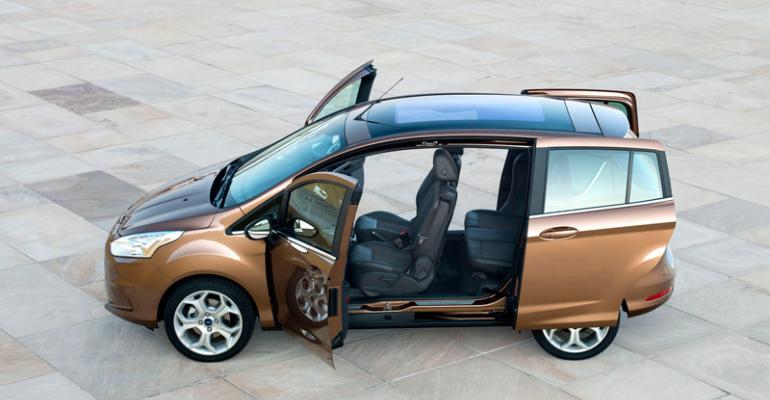The Ford B-Max is a revolutionary new product for Ford of Europe, but not because of its powertrain or innovative chassis. Its real claim to fame is its doors.
“That whole car was conceived around the door concept,” Darren Palmer, Ford product development quality director, tells WardsAuto.
“When we went to develop our next-generation B-segment multi-activity vehicle, we said we wanted the best possible door system for the customer.”
The idea was to provide the largest possible opening to the tiny car’s cabin. But the solution initially wasn’t clear.
Ford engineers mocked up a number of options, including suicide, sliding, dual-sliding and standard doors. Customer research indicated dual-sliding doors represented the best option, but on a car the size of the B-Max the B-pillar would get in the way, limiting their advantage.
“That meant going for a B-pillar-less design,” Palmer says. “(But) we had to ask ourselves if we had the technology to do it.”
High-strength steel, up to five times the strength of conventional steel, proved the answer. The B-Max employs the material in key body and door components to create an “extremely strong and stiff structure” without adding weight, Palmer says.
To further minimize heft, the high-strength steel load-bearing sections were designed like a “crane structure,” he says, with crisscrossing latticework. “So there are no penalties for stiffness or weight.”
The new design went through extensive testing to ensure it provides the same crash protection as a conventional structure. More than 1,000 computer simulations were conducted over three years to optimize side-impact performance. Each simulation took 24 hours to complete and required the equivalent computing power of eight high-end PCs.
Fifty real-world side-impact crash tests followed.
“To maintain the stiffness of the car, the ring around the door has a lot higher use of ultra-high-strength boron steel that passes load up through the roof and down through the floor,” Palmer says. “So it has good crash performance in every single crash mode.”
The result is a 4.9-ft. (1.5-m) unobstructed opening on either side of the car, which the auto maker says is unique in the B-segment. But producing the design represented another hurdle, as Ford’s European stamping operations lacked the equipment necessary to form high-strength steel.
“You have to stamp (high-strength steel) when hot, and traditional facilities are not set up to do that,” requiring Ford to upgrade a number of plants, Palmer says.
While other vehicles have offered innovative rear-door designs, including the reverse-hinged small rear doors on the Mazda RX-8 sportscar, most require the front door to be opened before the rear can be accessed.
Ford is counting on the unique setup in the B-Max to provide a competitive advantage in Europe, where the small cars that dominate the market offer limited utility.
Palmer says the doors could be enough of a difference-maker to lure buyers from larger C-cars to the B-Max.
“I’m 2-m (6.5-ft.) tall and I can fit in the back seat in comfort with someone in the front,” he says. “I usually have to be in a C-Class (vehicle) to get anywhere near that.”
Palmer won’t identify future applications, but says the door concept is likely to migrate to other Ford vehicles if it proves popular.
The B-Max, powered by a 1.0L direct-injected turbocharged EcoBoost engine, goes on sale in August in most European markets.
Ford expects the vehicle to sell in “significant” volumes, Palmer says.
“Many (consumers) want the smallest car they can get away with,” he says. “We’re seeing people moving down from larger-segment cars, and they spend more on a car than they used to.”





